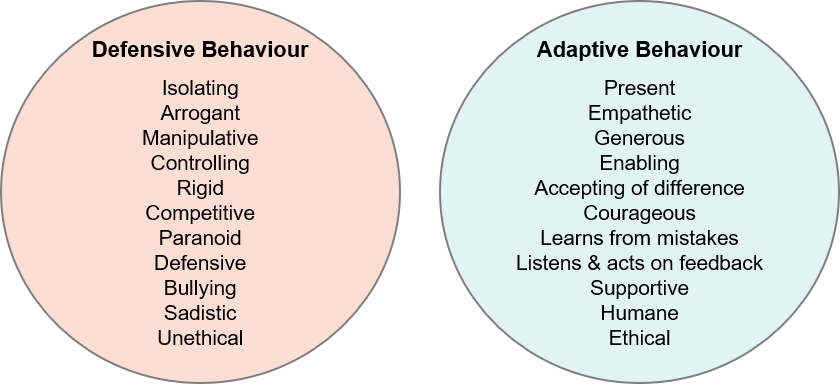Fake Leadership and Toxic Workplaces (Part 1)
By Nicole Barrett, Psychologist
Jul 05, 2019

This is the first of a 2-part commentary taking a closer look at the concept and practices of fake leadership and how this contributes to toxic work environments. The notion of the corporate psychopaths and narcissistic leaders is not new, yet the increasing visibility of corruption and unethical leaders offers us a timely reminder to revisit this undiscussable and explore what is actively not being said and, in these current times, needs to be overtly talked about.
A recent confrontation with fake leadership has inspired me to offer the thoughts in this article. Insight to Influence was conducting research into an organisation’s culture and employee engagement. When it came to preparing the report, the leader requested that we delete entire sections of the collected data including significant themes that emerged throughout the process. These themes showed the employees’ lived experience of leadership, that fell short of their expectations. Of course, I could not in good conscience dishonour the participants’ contributions. Nor would I corrupt the data and integrity of the report to create fake news which would paint an artificial picture of the leadership’s practices. Where this landed is that an internal resource re-wrote our report and, for a short period, I felt vexed and completely compromised. In the end, I was simply left wondering, what the heck is going on? How have we arrived in a time where leaders craft their own imagined reality in order to look good?
I’m drawn to aspects of the current context and system that amplify the presence of fake leadership. As a Western European society, there is a colossal amount of focus and value on the almighty, omnipotent leader and there is no space for a mere mortal to ‘be’ like you and me with their moments of uncertainty, vulnerability, flaws and failures. Of course, the unintended consequence of our dependency and obsession with the idea of a ‘perfect’ leader, a superstar and a saviour, is that we are loading leaders up and co-creating and cultivating a new era of normalising narcissism where people go to extraordinary lengths to maintain their glorious sense-of-self which is being built on imagined realities that match the perversion of their self-propagation.
What does fake leadership look like?
Fake leadership uses the defence of emotions such as feeling threatened, shame, fear, rejection, anxiety or envy to source toxic behaviours that keep the imagined grandiose sense-of-self intact. From a contextual or cultural perspective, how leaders respond to these emotions is somewhat dependent on the extent to which the emotion is socially acceptable. That is, whether individuals are free to surface, express and explore the emotion and the consequences, or whether they are shunned, avoided or rewritten because the emotions of pain or anxiety don’t fit in with a grandiose prescriptive view or imagined world where leaders are perfect and pleasure rules.
We are all equally capable of narcissistic tendencies. An element of narcissism is necessary, it’s what gets us out of bed in the morning. Yet there are varying degrees along a continuum from a healthy dose of self-efficacy and drive to achieve goals, through to psychosis and highly destructive behaviours. Characteristics of fake leadership tend to emerge when there are extreme needs to be liked, perfect, in control or in the limelight. That said, the narcissist is susceptible to fake leadership because they are not comfortable with emotions, they don’t listen and are particularly sensitive to criticism - it is too painful for them to be wrong in any way, hence the rewriting of the report.
Fake Leadership arises from pleasure seeking, pain avoidance and an imagined reality. At the extreme end of the continuum, the following depicts defensive behaviours compared with adaptive behaviours that are possible when leaders authentically tap into and consciously use all of their emotions.

Some cultures acknowledge the connections between all emotion and the behaviours that make up our human reality, and that it is necessary to master a delicate dance that respects and utilises all parts of ourselves – the good, the bad and the sometimes ugly. In other cultures, many emotions are considered weak, painful or evil, so they are suppressed, only to manifest in unhelpful and usually unconscious ways. Whatever the driver, if left unattended, defensive behaviours place organisations at great risk and become toxic for both the leader and all of those around them.
Why is this happening?
Is it just me or is there a growing anxiety among our children, our leaders and the wider community? People seem more wired, impatient and worried - there is a yearning for something and this has a direct correlation with defensive behaviours to moderate or even eradicate the emotions. Defensive behaviours can show up in many different ways such as not listening, micro-management and doctoring reports, or even company results and KPI’s that may reflect poorly on the leader.
In the context of work, our research is revealing that toxic work cultures and fake leadership is very present. Leaders are becoming more driven by self-interests, blind to the impacts of their behaviour on others and struggling to build effective teams with open learning cultures that honour the competence of their people. On the one hand, I completely empathise with the plight of leadership and all that comes with it. For many of the leaders that we work with, they feel isolated, that there is a dependency on them, and they hold enormous expectations of themselves. On the other hand, at the very time these leaders need support, there seems to be a growing resistance to get to the heart of the issue and increasing motivations to distract, negate and ignore data that is telling a different story than the one they want to construct or promote. This is being accompanied by superficial interventions and efforts designed to be ‘seen as doing the right thing’ without any real commitment to learning, development and change.
With that in mind, it’s not surprising that we are also observing deep disenfranchisement among employees. There is a loss of trust and a high suspicion of leadership. People are not being heard which results in learned helplessness where they give up trying to make a difference - they show up, look busy, take their pay cheque and go home. We are noticing more and more people in survival mode. They stay under the radar, blame others, and an ‘us and them’ mentality is rife. Genuine integration and innovation are hitting an all-time low and work-related mental health issues are becoming more evident. All things considered, whatever is going on, we are all contributing to it and we are all paying for it in more ways than one.
It’s a complex issue, and I don’t profess to have all the answers, but we need to hit pause, reflect, get better at talking about how we react to feelings of uncertainty, vulnerability and being imperfect in an imperfect world, and then learn how to manage ourselves differently. During this process, it’s important that we don’t solely focus on the personality and style of individual leaders, but also consider the implications of the contextual and systemic elements at play (which are explored in Fake Leadership and Toxic Workplaces Part 2).
#fakeleadership #toxicworkplaces #insighttoinfluence
To find out how Insight to Influence can help you with culture, contemporary leadership development and team effectiveness, please contact us through the Insight to Influence website www.insighttoinfluence.com
Register to receive regular updates from our Insights Blog
Follow Insight to Influence on LinkedIn
Follow Insight to Influence on Facebook